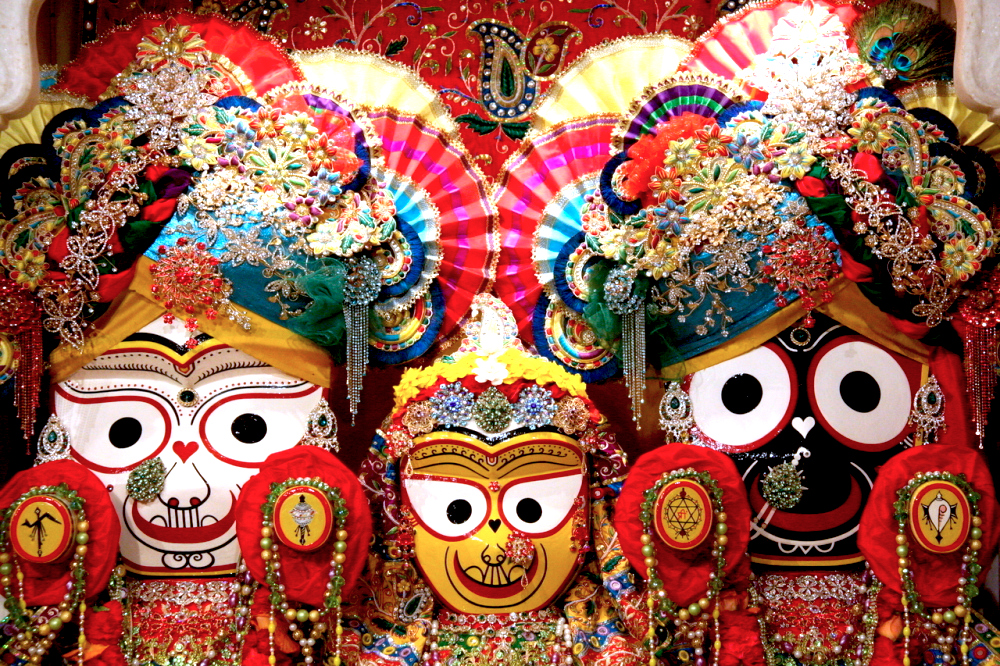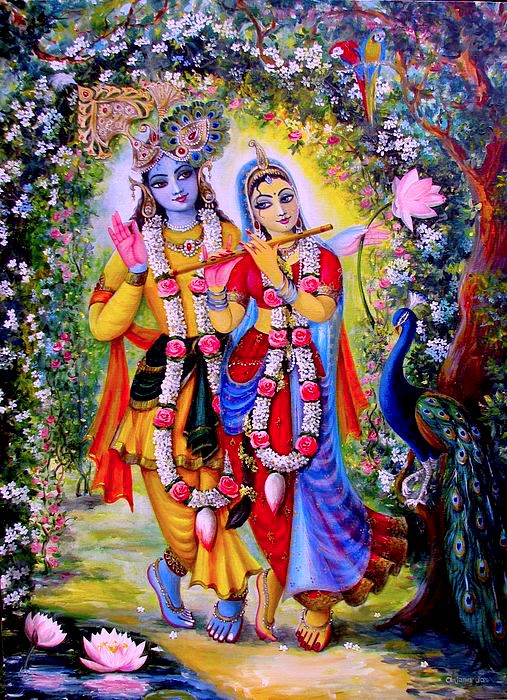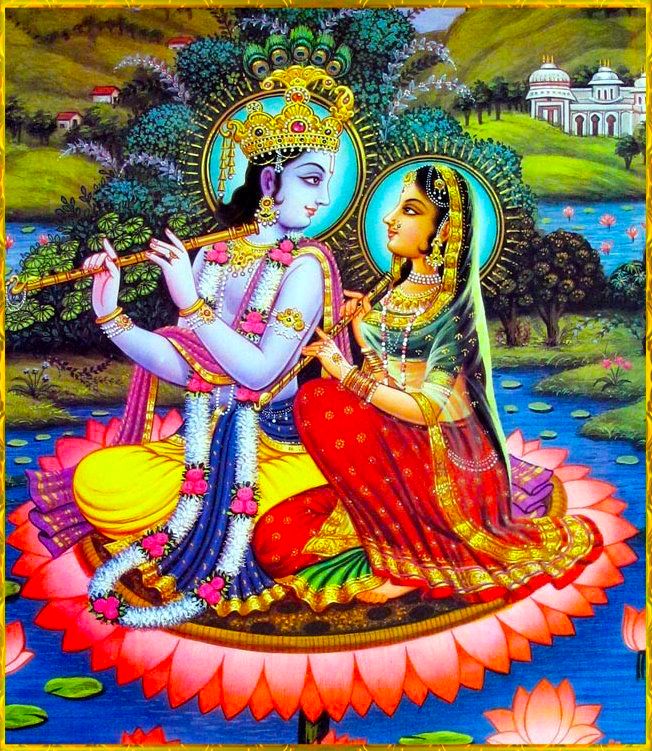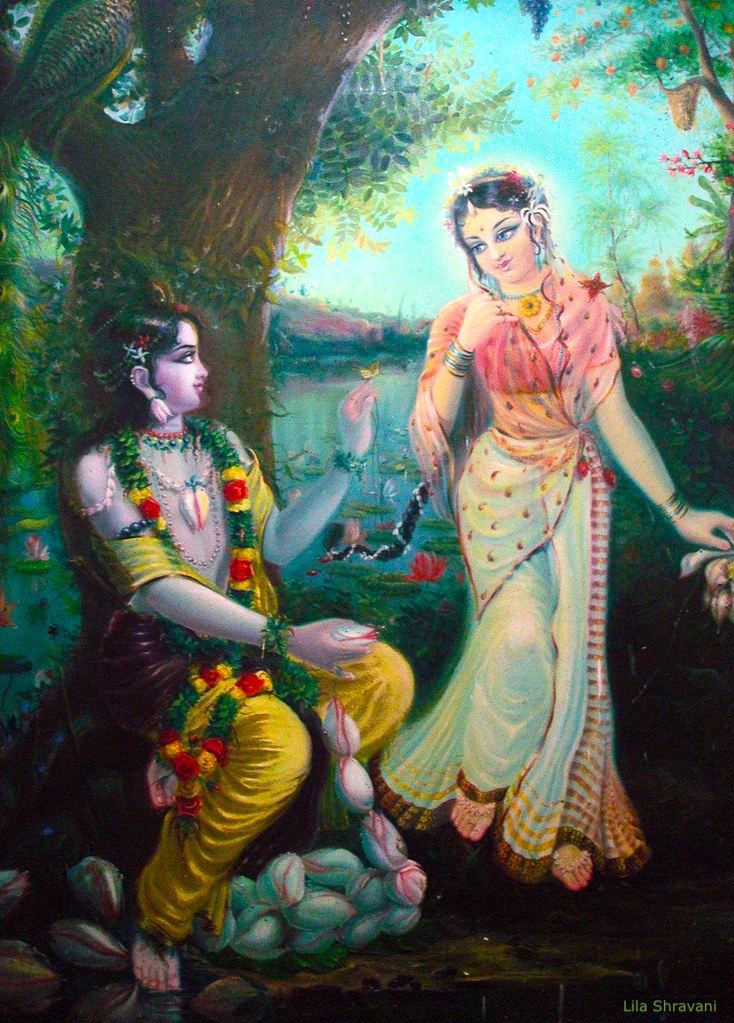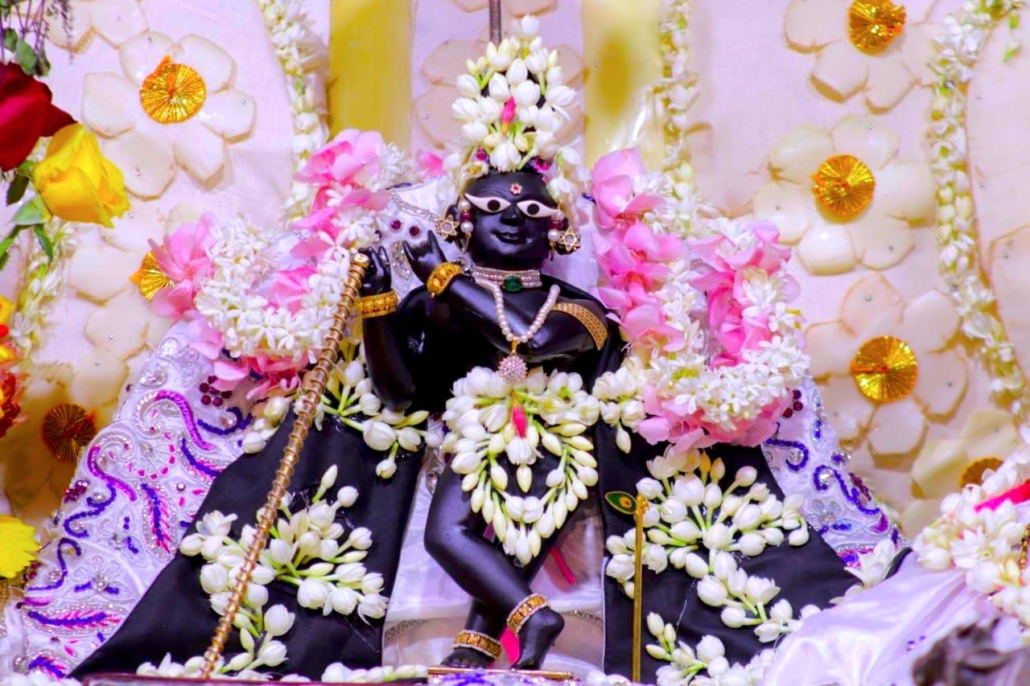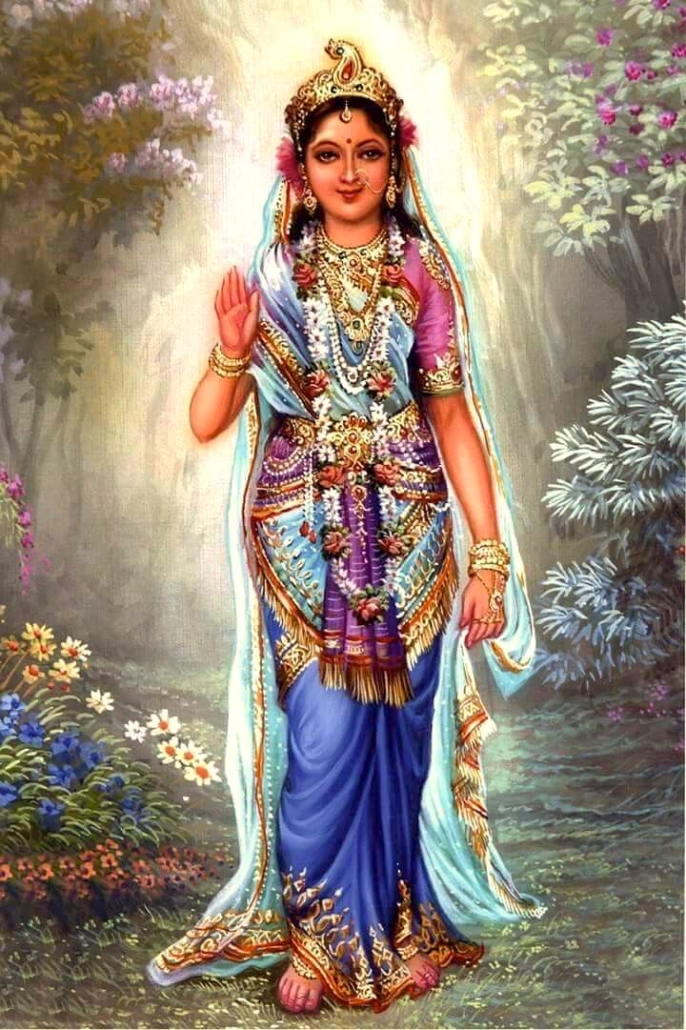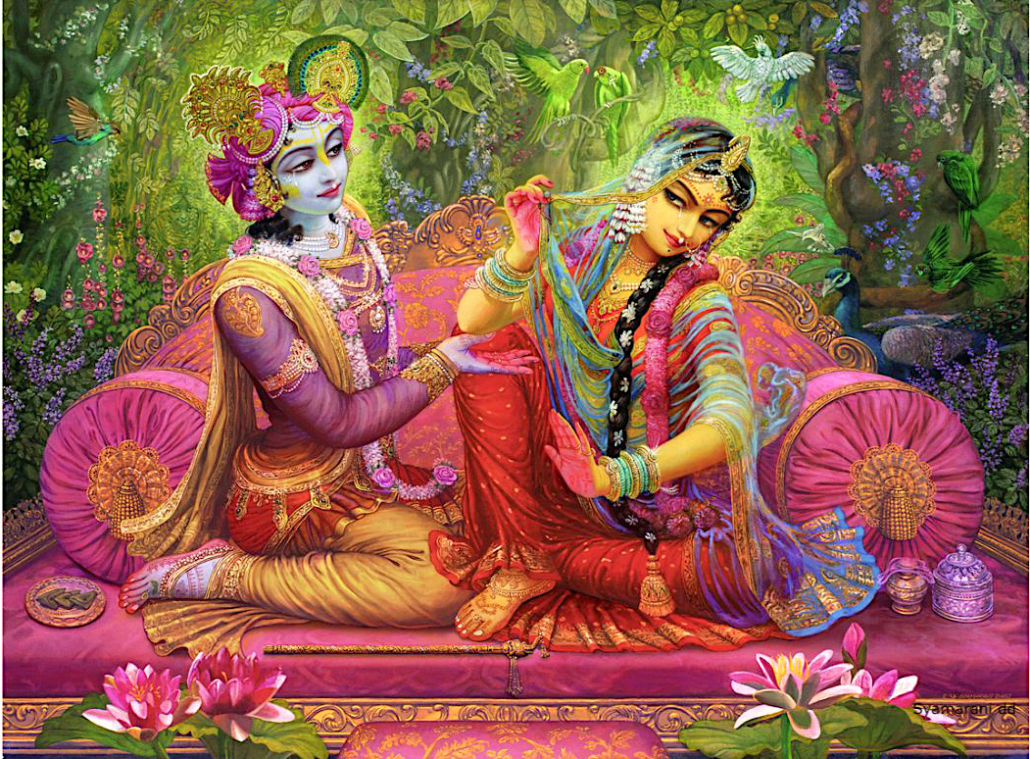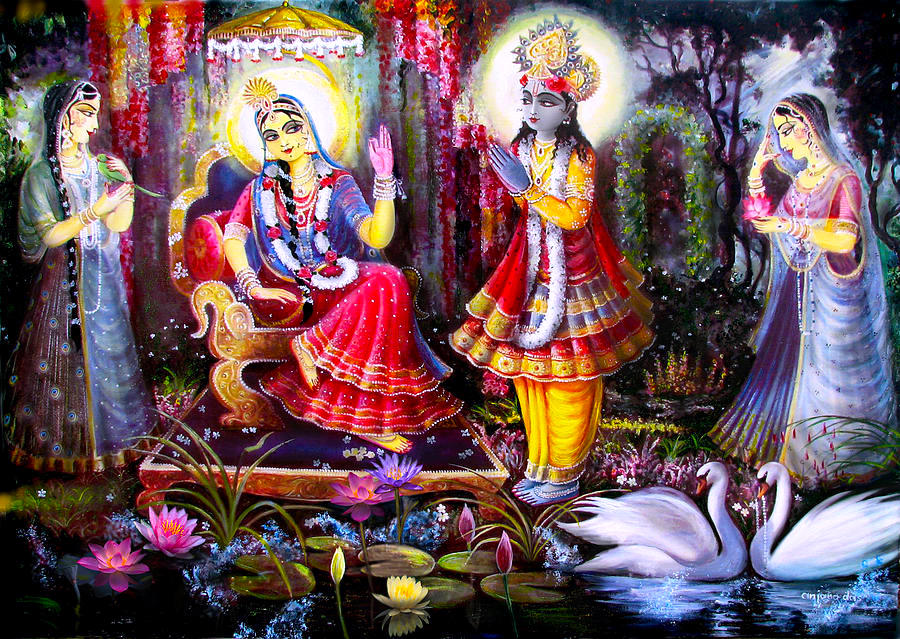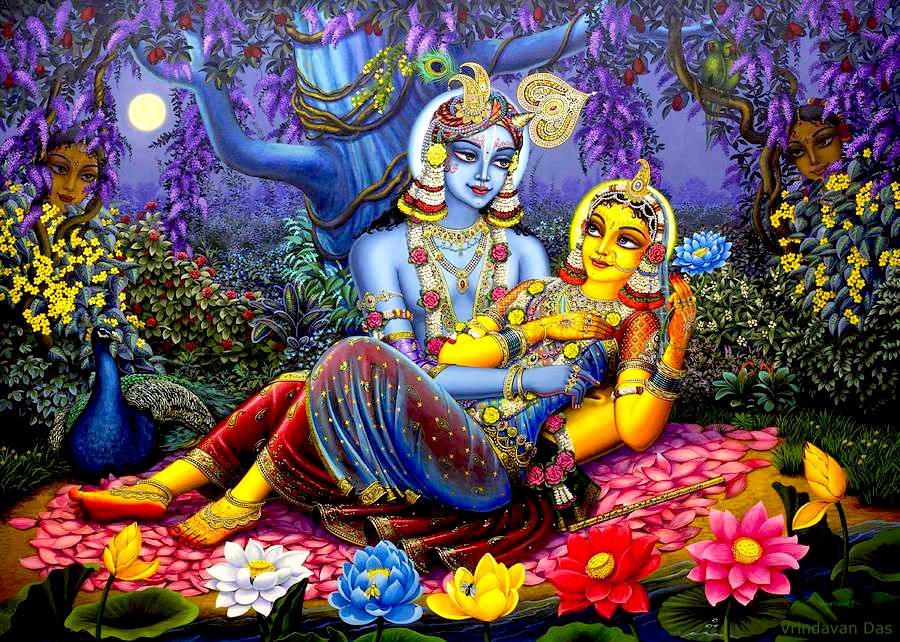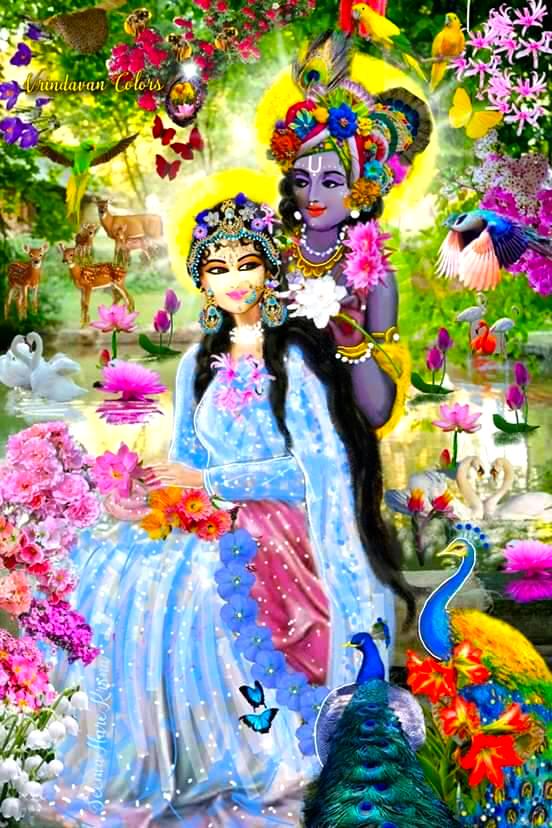Mahanidhi Madan Gopal Das
This audio series presents narrations of the occassional and eternal pastimes of Sri Chaitanya Mahaprabhu and Radha and Krishna. In Japa Walk Thru Lila Meditations, we mix japa chanting with meditation on Krishna’s pastimes. The result is a most wonderful, blissful, satisfying and enlightening experience of chanting Hare Krishna japa.
The practice of combining japa with lila meditation is a standard practice among most Gaudiya Vaisnavas. In fact, the founder-acharya of the world famous Hare Krishna Movement, Srila Prabhupada said, “You should know that it is not offensive to think of Krishna’s pastimes while chanting Hare Krishna japa. Rather IT IS REQUIRED!” (SP Letter Dec. 4, 1968)
The Japa Walk ThruLila Meditation Technique
1. Take your tulasi japa mala, and sit comfortably in a clean, sanctified place.
2. Play the desired lila audio tracks while listening through speakers, headphones or earplugs (or one ear plug).
3. Keep the audio player or the remote control within reach of your left hand, so you can occassionally pause or replay the audio track to deepen your contemplation on a particular scene, expression or loving exchange.
4. Start chanting the Hare Krishna Maha Mantra japa either silently in the mind or by softly whispering.
5. Adjust the audio volume so that you simultaneously hear the lila and attentively hear the Hare Krishna maha-mantra. Experiment until you find the perfect sound level that affords maximum concentration on both the pastimes of Krishna and His sweet Holy Names.
6. While chanting japa with full-heart concentration, listen to the lila narration while mentally trying to vizualize the pastime, to be there, to feel the loving exchanges of Radha and Krishna, and to think what seva you would be offering Them at that moment.
7. Whenever you want to deeply meditate or reflect upon a particular lila, a part of a lila, or a special exchange or scene within a lila, you can simply pause the audio track while continuing your nama japa. For example, sometimes we adjust our audio player so it repeatedly plays the same lila such as “Radha’s Morning Bath”.
Then while listening to that pastime and continuing our maha-mantra japa, we submerge our minds and hearts in all the minute details and sweet dealings of Srimati Radharani and Her sakhi/manjaris at that tender time of morning.
8. The japa walk thru technique is easy and blissful. Instead of wrestling with our wandering minds during japa, we can fill our minds with Radha and Krishna’s beautiful forms, qualities and pastimes while chanting. By this practice our scattered, monkey-jumping minds become pacified, pointed, and absorbed in hearing Krishna’s sweet Holy Names, mentally seeing Krishna’s form and pastimes, and feeling the hearts of Krishna and His loving friends.
9. After sometime of chanting japa and listening to the japa walk thru series, you will no longer think you are just a listener or observer of the lila. If Sri Krishna is merciful to you, you will feel that you are personally there, directly walking with Radha and Krishna and serving Them in every possible way. This is the perfection of Hare Krishna Maha Mantra japa. And this audio series is presented to help everyone attain this perfection.
Maha-mantra Radha-Krishna lila meditation ki jai! Jaya Jaya Sri Radhe!
Mahanidhi Madan Gopal Das
Please read previous part one before.
On the path of Radha-Krishna bhakti bhajana, one must pass through nine steps or stages to reach the final goal, Krishna prema.
1) Beginning with faith in Sri Krishna (Shraddha); bhakti grows, deepens and progresses successively through the levels of:
2) Sadhu sanga;
3) Bhajana kriya (practicing nine limbs of Radha-Krishna hearing, chanting and remembering);
4) Anarthanivrtti (sensual, mental and emotional, purification);
5) Nishtha (firmness, strong conviction, enthusiasm and mental peace);
6) Ruchi (taste, joy and fulfillment in bhakti bhajana;
7) Asakti (strong attachment to Radha-Krishna with intense yearning to meet Them);
8) Bhava (experience spiritual ecstasy, and intense desire to see and intimately serve Radha-Krishna along with occasional deep visions or even darshana;
9) Krishna prema (the final stage of perfect, transcendent loving bliss eternal, and constant rapturous Vrajamadhurya-lila immersions in one’s siddha.
One should be forewarned, however, that the fourth stage, anarthanivrtti (cessation of offenses and all bad habits), is the most difficult one to pass through. It may take lifetimes!
In Madhurya-kadambini (3.16,18), Srila Visvanatha Cakravarti explains exactly how aparadhas and anarthas i.e. offenses, unwanted obstacles and impediments gradually disappear from the mind and heart of the sincere sadhaka. He describes five stages in gradual cessation of all aparadhas and anarthas:
STAGES OF PERFECTION IN KRISHNA CONSCIOUNESS:
1) Partial—15% anarthas & aparadhas destroyed; Bhajankriya stage.At this stage one is 15% attached to serving and being with Krishna and 85% attached to enjoying his/her material body and senses. 15% Krishna consciousness v.s. 85% MAYA!
2) Pervasive—75% anarthas & aparadhas destroyed; Nishtha stage.At this stage one is 75% attached to serving and being with Krishna and 25% attached to enjoying his/her material body and senses. 75% Krishna consciousness v.s. 25% MAYA!
3) Almost complete—95% destroyed; Bhava stage. 95% Krishna consciousness v.s. 5% MAYA!
4) Complete—100% destroyed; Prema stage. 100% Krishna consciousness v.s. .0,01% MAYA!
Even here however, there is a slight chance anarthas may reappear. Sri Rupa Gosvami confirms this: “Yes, it’s true and possible that even at the stage of bhava or prema, one may commit an aparadha if one offends a great devotee of Bhagavan Sri Krishna, Krishna presthaaparadhatah.”(Bhakti Rasamrita Sindhu 1.3.54)
5) Absolute—100/100% destroyed; 100% Krishna consciousness v.s. 0,00% MAYA!
For the fully realized Krishna premibhakta, the cessation and destruction of ALL ANARTHAS AND APARADHAS IS ABSOLUTE because one has received the complete mercy Sri Krishna along with His direct seva and association (sakshad seva & sanga). There is not even the slightest chance for the appearance of anarthas or aparadhas. One has now attained the perfection of his/her human life and the final goal of Krishna consciousness.
Thus one can see that advancing in Radha-Krishna bhakti bhajana is a gradual process that may extend for many lifetimes.
In Sri Gita, Bhagavan Sri Krishna explains this point:“In the next life, one is automatically attracted to the type of sadhana bhajana one practiced in the previous life, pūrvābhyāsena tenaiva hriyate hy avaśo ’pi saḥ.”(Bhagavad Gita 6.44)
Sridhara Swami tika:“Thus struggling under the momentum of his former practice, the sadhaka gradually attains liberation in Krishna consciousness.”
Sri Krishna continues, “Unlike one’s previous life, the bhakti yogi will now strive for spiritual perfection with intense effort and become purified of his/her anarthas and aparadhas. Then after many births, one will finally attain perfection in Krishna consciousness, Krishna prema. (6.45)
prayatnād yatamānas tu, yogī saṁśuddha-kilbiṣaḥ
aneka-janma-saṁsiddhas, tato yāti parāṁ gatim
Sri Baladeva Vidya bhushana tika: “Due to fear of his previous obstacles, the sadhaka now makes even more effort in bhajana. And this additional effort purifies one of all material desires.”
Srila Prabhupada tika: “With determination, therefore, the bhakta begins his/her unfinished task, and thus one completely cleanses oneself of all material contaminations. When one is finally free from all contaminations, one attains the supreme perfection—Krishna consciousness.”
The principle of a gradual process also applies to the realization and perception of one’s Guru received or mentally conceived siddha svarupa, siddha deha. In the beginning, awareness of one’s eternal, transcendental female identity as Srimati Radharani’s loving loyal maidservant is slight, and bodily attachment is great. Gradually as one advances in meditation and receives more mercy from Sri Krishna and Sri Guru, he/she will more deeply identify with the siddha deha and Sri Radha’s seva, and simultaneously identify less with the external material body and enjoying material sense gratification.
The material body and siddha deha are like communicating vessels—more identity with body, less identity with siddha deha; or more identity with siddha deha, then less identity with one’s temporary material body.
In this regard, Srila Prabhupada said, “The more we make progress in Krishna consciousness, this ‘my consciousness and I consciousness’ will vanish. So this is a natural consequence. And as soon as you begin to eat, your weakness will disappear along with your hunger and satisfaction will come.
“Similarly, these two things cannot stand together, maya and Krishna. If I am in Krishna consciousness then there is no question of maya. It may be that I’m not fully Krishna conscious. Just like while eating it is not that immediately my hunger is satisfied; it takes a little time. Similarly, Krishna consciousness is a gradual process of advancement. That is the test. If I am still in illusion, then I should understand that my Krishna consciousness is not progressing. This is the test.” (folio: 670116CC.NYC)
Further, Srila Prabhupada said, “Material hankerings and spiritual advancement go ill together. (Srimad Bhagavatam 1.8.27 tika) Material attachment and taking shelter of the lotus feet of Bhagavan Sri Krishna go ill together. Material attachment means ignorance of transcendental happiness under the shelter of Sri Krishna (Srimad Bhagavatam 1.12.27 tika). Increasing one’s love for Krishna is a gradual process. “(folio: TLK Verse 36)
In the next wonderful quote, Srila Prabhupada perfectly and beautifully explains the gradual journey to Krishna prema:
“The development of intimacy between Bhagavan Sri Krishna and the living entity happens by a gradual process of progressive devotional activities. Such a progressive march of transcendental devotion for Sri Krishna culminates in the attainment of loving service of Krishna, which is called prema in different transcendental varietgatedness called rasas, [astonishingly tasty, loving divine mellows].” (Srimad Bhagavatam 1.5.37 tika)
The conclusion is that one must try his/her best to perform bhakti bhajana, all the while understanding that perfection does not come easy. One should think, “Krishna prema may come in one life, two or even ten lifetimes, but still I must attain this perfection no matter what! The joy, the peace and the fulfillment I have found so far in bhakti bhajana completely eclipses and surpasses all other pleasures I obtained by trying to enjoy my body and this mundane world.
“I am totally convinced that nothing else in this world but Krishna consciousness is so supremely beautiful, sweet, blissful, tasteful and fulfilling. I know that I am far, far away from Krishna prema perfection, yet I will keep moving on and on. I am sure that if not now then in some future life, my most loving and merciful Radha-Govinda Yugala will grant me Their sweet love, Their blissful darshana and Their tight, loving embrace!!!!
Bhakti bhajana ki jai! Radha-Govinda Yugala prema seva in Vrajanikunjas ki jai! Jaya Jaya Sri Radhe!
Mahanidhi Madan Gopal Das
The “Japa Mini Lila Meditation” series presents short audio files describing transcendental sevas and lilas to be meditated upon while chanting one to two rounds of Hare Krishna japa.
These Radha-Krishna nitya-lila meditations are very helpful for sadhakas aspiring to become eternal maidservants (manjaris) of Srimati Radharani. For other devotees, the meditations will give a taste of an amazing inner joy and satisfaction that arises from combining nama-japa with Radha-Krishna lila.
The Basic Meditation Technique
While attentively chanting japa and listening to the audio, try to mentally visualize the time, place, personalities and pastime being described. Completely forget this world and think that you are in the spiritual realm of Vrindavana, standing right beside Srimati Radhika and expertly serving Her in so many special and intimate ways.
Try to see, hear and take part (mentally of course) in all the loving exchanges of Radha-Madhava, Their sakhis and the manjaris in the lilas you are hearing. Try to feel what they are feeling, saying and doing by mixing your heart, even in small way, with the heart of Sri Radha and Her dasis, the manjaris. Intensely pray for the mercy of your beloved Gurudeva, and also Sri Rupa Manjari, Sri Tulasi-manjari (Sri Raghunatha Dasa Goswami) and Sri Radhika to help you identify, albeit in a tiny way, with Their feelings and moods during each wonderful lila.
In your known or desired mentally conceived and cherished spiritual body (siddha svarupa) try to visualize that you are seeing, hearing, speaking, serving and personally moving with Radha-Krishna in Their beautiful sweet pastimes as they flow on into eternity.
For the meditation to be fruitful, blissful and transforming, however, you must use your powers of concentration and visualization. Concentration means to withdraw your mind from all internal thoughts and external sense stimuli. Visualization means to mentally “see” the whole panorama of the setting, the personalities, the clothes, the colors and the various articles and places being described in the narration.
Focus all your conscious attention on the lila narration and the internal vibration of the Hare Krishna maha-mantra. You can become peaceful and increase your concentration on hearing the Divine Name and visualizing the lilas if you close your eyes, relax your face, and breathe slowly and deeply while fixing your attention on the point between the eyebrows. Try to really feel and mentally identify yourself as a humble serving maid of Srimati Radharani who really wants to be there with Sri Radha, serving Her and Her beloved Sri Krishna from moment to moment in the eternal realm of loving bliss—Vrindavana.
Japa lila meditation is a sadhana, and like all sadhanas one must practice it every day without fail. In the beginning, it will be difficult to hear and chant while simultaneously concentrating and visualizing the pastimes. However, by daily practice (abhyasa), your ability to concentrate and visualize will improve more and more.
Within a short time of six months or so of diligent practice, you will definitely have some amazing meditations, and also experience an extraordinary taste of transcendental sweetness by this Japa Mini Meditation practice.
It is also very important to remember that during any sadhana practice, you must always remain humble and patient, feeling confident that our affectionate Loving Lord Sri Krishna will surely reciprocate with our efforts and bring us success.
So now let’s begin the Japa Mini Lila Meditations. Jaya Jaya Sri Radhe!
Mahanidhi Madan Gopal Das
After coming to Vrndavana, Sri Gopala Bhatta Gosvami used to worship eleven salagrama silas. He never had a fixed residence. Carrying His salagrams in a cloth bag, he would wander around Vraja just like Sri Rupa and Sri Sanatana Gosvamis. Once a wealthy man, desiring to serve Gopala Bhatta, gave him some opulent cloth and ornaments.
Gopala Bhatta kept those gifts and thought, “If I had a Deity then I could nicely decorate Him with these things.” That evening after offering bhoga and arati to his salagrama-silas, he put them to rest in a basket. The next morning after returning from his Yamuna bath he started his salagrama puja. He was completely astonished when he woke the Lord, and found a gorgeous Deity of Krsna playing a flute. There were now ten silas and this Deity.
Overwhelmed in spiritual bliss, he fell to the ground and offered dandavats¸avats. Then he recited various stutis and stotras [hymns and prayers]. Sri Rupa, Sanatana, and many other devotees came running when they heard the amazing news. The whole universe became enchanted by the Lord’s beautiful form. Everyone just gazed at the Lord as their tears fell in streams to bathe Him.
The Deity of Sri Radharamana Deva appeared on the full moon day of Vaisakha in the year 1542. Radharamanaji is one of the few original Deities of the Gosvamiss who never left Vrndavana. Radharamana Deva still receives a high standard of worship full of loving attention in His temple beside Nidhuvana in Vrndavana.
Sri Radharamana Deva has a uniquely gorgeous form. He has a smooth and brilliant Syama-blue complexion, a broad chest, long arms, a waist as thin as a lion’s, and powerful sloping thighs. He has many intricate features which include lotus-petal eyes, fingernails and even teeth. Anyone who even once sees His all-attractive threefold bending form will be captivated forever. On the back of Radharamana one can still see parts of the original salagrama sila from which He manifested.
In Goloka Vrndavana, Gopala Bhatta is Sri Radha’s beloved maidservant named Guna Manjari. Let us remember the mind-enchanting Sri Radharamana Deva, and pray for the mercy of Sri Gopala Bhatta Gosvami as we meditate on the following translation of a sucaka kirrtana written by Manohara Dasa.
“Whenever I see the beautiful lotus feet of Sri Gopala Bhatta Prabhu my eyes flood with tears. One becomes free from the cycle of birth and death by hearing about your unlimited qualities. Being attracted by your moonlike face and lips, which are radiant like the rising sun, I am no longer pierced by Cupid’s ten golden arrows. Your beautiful teeth resemble a string of pearls. Your joyful words are saturated with the sweetest nectar.
Sri Rupa and Sanatana, Dasa Raghunatha, Bhatta Raghunatha, Raghava Panditá, Kaviraja Gosvami, and Lokanatha Gosvami are your life. Radharamanaji is your very soul. You offer obeisances to Lord Caitanya with your body overflowing with love. You are like a honeybee attached to His nectarean lotus feet. You so kindly gave shelter to Srinivasa Acarya [his disciple]. Your only activities are relishing rasa, associating with pure devotees, and tasting the divine madness of gopi bhava.”
“The pastimes of Radharamana flow through your mind like the celestial Ganges. You are the crest-jewel of rasika Vaisnavas. By relishing prema rasa you become overwhelmed with ecstatic emotions. Oh, ocean of spontaneous love for Radharamana, you are the friend of the fallen.
“Your fame is sung throughout the universe. Your divine form is sweet to behold and full of mercy. Your unlimited transcendental qualities act like a touchstone. O master, just once let me see your lotus feet, which are the essence of all sweetness.”
“After many many births I have attained the rare fortune of serving the servants of your eternal associates. Due to my bad karma I have simply wasted my life enjoying sense gratification. I am full of offenses. My only hope is that you, who are full of merciful qualities, will deliver this fallen soul. I am greedy and sinful, and although my mind is fickle, still this Manohara Dasa calls out to you: Please don’t neglect me!”
Sri Sri Radharamana Deva ki jai!
Gopala Bhatta Gosvami ki jai!
(An excerpt from Radha Kunda Mahima Madhuri)
Mahanidhi Madan Gopal Das
Srimad Bhagavatam is called the “king of all spiritual books” (Grantha Raja) for good reason. Within this triguna-free, transcendental treatise, the amala-purana, which showcases the absolutely selfless, divine love of Srimati Radharani, one can find all the sweet, majestic and beautiful truths about the sadhana and sadhya (daily practice and perfection) of Gaudiya Vaisnavism.
In his most compassionate and wonderful shastra, Sri Chaitanya Caritamrita, Sri Krishna Dasa Kaviraja summarizes the teachings of Sri Caitanya Mahaprabhu and the six Goswamis of Vrindavana by mentioning the same Bhagavatam verses that they used to substantiate their sublime instructions.
To emphasize the importance of these particular verses for all Gaudiya Vaisnavas, the same Bhagavatam verse is often mentioned two, three or more times in the Sri Chaitanya Caritamrta.
This series of posts presents these verses, along with selected tikas of our acharyas and the compiler. We will cover the beautiful truths, tattvas, of Krishna, Radha, Vaisnavas, Sri Guru, Bhakti Sadhana, Nama, Prema and more.
Where Does Bhakti Come From?
In Uddhava-gita, Sri Krishna answers this question saying:
yadrcchaya -mat-kathadau
jata-sraddhas -tu -yah -puman
na -nirvinno -nati-sakto
bhakti-yogo -’sya -siddhi-dah
If by unexpected association with devotees one develops faith in hearing hari-katha, such a person, who is neither completely detached from sense gratification nor too much attached to it, can attain perfection by practicing bhakti-yoga. (Srimad Bhagavatam 11.20.8)
Comments Mahanidhi Madan Gopal Das:
Some translate the word yadrcchaya as “by good fortune”. However, the dictionary meaning of yadrcchaya is “complete independence” or “freedom of will and action” and that is the meaning in this verse.
Sri Jiva Goswami tika:
The cause of bhakti is faith alone. That is explained in this verse. Faith arises from associating with devotees (yadrcchaya). The person develops faith in Krishna-katha and thinks, “This Krishna-katha is the best.” One then becomes disgusted with other activities.
However, one cannot give up objects of enjoyment which are the remnants of results of pious acts from previous lives even though one knows they give suffering. This person is not completely detached and not too attached. This is the devotee’s initial state. (Bhakti Sandarbha 171)
Visvanatha Cakravartipada tika:
A person develops faith (jata-shraddha) in Krishna-katha by the merciful association of devotees (yadrcchaya). That is the meaning of yadrcchaya in this verse. By the unexpected association of the devotee, even a person extremely attached to sense objects becomes qualified for bhakti.
The cause of a devotee’s mercy manifesting itself is bhakti itself residing within the devotee’s heart. Without the devotee having bhakti, there is no possibility of the devotee manifesting mercy to others. Bhakti causes the devotee’s mercy which causes bhakti in another person. Bhakti causes bhakti. The self-manifesting, causeless, independent nature of bhakti is thus concluded.
Pandit Sri Ananta Dasji Maharaja tika:
That bhakti manifests in an individual without any reason is the intent of this text. The word yadrcchaya, “by chance,” appears repeatedly in the Bhagavatam. Bhakti’s appearance in an individual does not depend on any external cause.
One may ask, if devotion is truly spiritual, then how can it manifest in a devotee’s material senses? The answer is that an iron bar put into fire attains the qualities of fire—brilliance, heat and the power to burn. So too bhakti, by its own potency, destroys the material nature of a person’s senses and spiritualizes them.
Shruti and Smriti describe bhakti as sac-cid-ananda-mayi just like Bhagavan Sri Krishna and as a self-manifesting aspect of Sri Krishna’s svarupa-shakti. It is only by the mercy of devotees that ordinary human beings can attain bhakti. As Krishna is under the control of His devotees, His mercy follows that of a devotee.
By carefully considering this point, one can understand that it is bhakti herself, residing in the heart of a devotee, that causes the devotee to give mercy to others. The conclusion is that bhakti alone is the cause of bhakti. Bhakti does not depend on any other cause for its appearance. Bhakti residing in a devotee’s heart, inspires one to act mercifully to others.
Krishna on the other hand is always absorbed in His own divine bliss and can therefore not feel the pain of the conditioned souls. Compassion arises only when one becomes aware of another’s misery. As Sri Krishna is the embodiment of concentrated bliss, it is impossible for even the omnipotent Krishna to truly feel pity for the bound jiva.
The only way the misery-bound souls can attain liberation is through the independent kindness of a Vaishnava. However, Vaishnavas also exist in the realm of bliss, but they can remember the miseries of their previous lives.
Sri Krishna has given full independence to His devotees to give blessings to others, and these blessings are the only way to reach Bhagavan Sri Krishna. The conclusion is that the jivas can only receive Krishna’s grace through the form of a devotee and not directly from Him. (Madhurya Kadambini tikas)
Comments Mahanidhi Madan Gopal Das:
Vaishnavas are the personified forms of Sri Krishna’s mercy, krpa-shakti-murtis. Vaishnavas have direct experience of the struggles, anxiety, tension, stress, frustration, pain and miseries of material existence.
And they themselves are the recipients of mercy, krpa-patras, from other kind-hearted, compassionate Vaishnavas. Thus, without the mercy of a Vaishnava no one can attain bhakti and the eternal loving service of Radha Govinda Yugal in Goloka Vrindavan!
Vaishnava krpa-shakti murtis ki jai! Jai Jai Sri Radhe!
Mahanidhi Madan Gopal Das
These amazingly sweet and charming nectar-filled verses will carry you into the realm of Srimati Radharani’s eternal seva. The original Sanskrit verses of Radha Rasa Sudha Nidhi by Sri Prabodhananda Sarasvati are all incomparably beautiful and worthy of remembrance.
However, since most people cannot memorize Sanskrit verses, we have presented mostly just the English translations. These verses paint wonderful lila pictures for meditation on Radha Krishna’s Vrajalilas. And most importantly, they will help a sadhaka to adopt the feelings and sentiments, gopi-bhava, of a dasi of Sri Radha. The verses have titles to facilitate their remembrance.
Verse 191 Manjari Protects Radhika
O Radhe! When will I follow You down the road and fully enchant You and Your rasika lover by pushing Krishna away from You while saying, “O most shameless boy! Don’t come anywhere near my dear friend, who becomes enchanted like a little girl whenever You simply touch the borders of Her breasts!”
Verse 208 Manjari Protects Radhika
O Radhike! When will I hide the signs of Your amorous union with Krishna from Your cruel superiors by saying, “My sakhi was picking flowers far away from here, and on the way back Radha’s breasts were scratched by the thorns, Her tilaka was washed off Her forehead from sweating, and Her lips were bruised by the cold wind!”
Verse 213 Sleeping Manjari
When will I somehow fall asleep at the end of Your flowerbed while I am softly massaging Your lotus-feet, padambhoja -samvahanani -shayyante -patita -prapta -tandra -bhaveyam?
Verse 219Manjari Helps Krishna
O Pranayini Radhe! When You are angry with Krishna, He falls at my feet, holding a straw between His teeth, and prays to me with many pitiful words. Krishna constantly follows me to ask me to arrange a meeting with You. O Radhe! I am tired of this, so now I submit Krishna’s plea to You.
Verse 224 Manjari’s Humor
O Vrshabhanu-nandini! When will I tell Your Priyatama, “O Gopendra-kumara! Don’t vainly make such proud jokes over here! With great difficulty You held one Govardhana Hill on Your hand. But as soon as You even see Sri Radha’s two golden mountains You become afraid, sri -radha -hema -shaila -yugale -drshte -bhayam!”
Verse 243 Radha Teaches Manjaris
When will my Ishvari Radha engage me in serving Her Praneshvara Sri Krishna in the solitary places of Vrindavan by teaching me how to string flower garlands, grind sandal paste, make wonderful sweet-balls, and sweep the kunja?
Verse 246 Krishna’s Bewilderment
May Sri Radha’s smile protect us when Radha smiles upon seeing Hari marveling at His own form reflected in Radha’s shining golden breasts. At that time, Krishna says, “O Radha! I see two beautiful boys in Your breasts! Their luster steals the glories of hosts of blue lotus-flowers! I am completely enchanted by their forms. Please make Me Your girlfriend, so that we two girls can tightly embrace these two boys!”
Verse 247 Radha’s Bewilderment
O Radhike! When at the very beginning of Your love festival will I hear You sarcastically tell Shyam, “O Nitigya! (knower of morality) Stay away from Me!”
Then I will watch You push away Krishna’s hand before You storm out of the kunja to go angrily lament with tear-filled eyes to Your sakhi’s that You just saw Krishna with another sakhi. Although it was actually Your own sweet form seen in Krishna’s Kaustubha gem.
Verse 259 Radha: Aim of Sadhana
I always meditate on Krishna wearing a crown of peacock-feathers. I always sing Krishna’s name in sankirtana. I always serve Krishna’s murti, and repeat His best of mantras, Gopala-mantra. During all these activities, however I am holding in my heart the desire to attain the supremely cherished service of Sri Radha’s lotus-feet.
Verse 267 Manjari Darshan
When will I, in a body maddened by ecstatic love, live in Vrindavan, that purifying, effulgent, and most amazing rasika abode that witnesses Sri Radha’s artful loving pastimes? And when will I clearly see my divine spiritual form, eyes, ears and so on that is just suitable for serving Radha Krishna in the effulgent kunjas?
Manjari meditations ki jai! Jai Jai Sri Radhe!
Mahanidhi Madan Gopal Das
These amazingly sweet and charming nectar-filled verses will carry you into the realm of Srimati Radharani’s eternal seva. The original Sanskrit verses of Vrindavan Mahimamrita by Sri Prabodhananda Sarasvati are all incomparably beautiful and worthy of remembrance.
However, since most people cannot memorize Sanskrit verses, we have presented mostly just the English translations. These verses paint wonderful lila pictures for meditation on Radha Krishna’s Vraja lilas. And most importantly, they will help a sadhaka to adopt the feelings and sentiments, gopi-bhava, of a dasi of Sri Radha. The verses have titles to facilitate their remembrance.
Sataka 14.57 Manjaris’ Guru
Radhika personally teaches her dasi manjaris, radhika -dasih -shikshayate.
Sataka 14.70 Manjari Begs Radha Krishna
A manjari holds the lotus feet of Radha Madhava and begs, “O Swami and Swamini Radha! Please come to my dear sakhi’s supremely charming kunja.” Radha Madhava then happily go there and lavishly praise that dasi. Just meditate on this.
Sataka 15.2 Manjari Makes a Garden
With her own hands the manjari prepares an astonishing flower garden in the forest of Vrindavan. Within it she builds a charming mandap and decorates it with varieties of fragrant flowers. She sprinkles lots of soft lotus petals on the path leading to that mandap. Radha Govinda Yugal then come there and enjoy many loving pastimes.
Sataka 15.44 Sakhis Teach Manjaris
The main gopis like Lalita and Vishakha personally teach their own extraordinary arts and skills to the newly arrived young gopis, sadhana siddhas, nava -prakata-ballavih -samupashikshya -mukhyalibhir, nijam -nijam -ananyagadbhutatamam -kala-kaushalam.
Radha Govinda merge in happiness whenever They call out the names of these wonderful new manjaris and accept their seva.
Sataka 15.73-75 The Topmost Secret Mantra
I will tell you a mantra hidden from the Vedas, and not found anywhere even in the most confidential scriptures. This infinitely glorious mantra is the sweetest nectar, the zenith of all auspiciousness, and the ultimate goal of all attainments.
It is the supreme madness of all forms of maddening bliss. It is the secret of all secrets. Without thinking of anything else, day and night chant this mantra: RADHA!
Sataka 15.83 Extreme Intimacy of Manjaris
All glories to Radha, who on the pathway just outside the nikunja confides to her manjari saying, “O auspicious well behaved dasi, anuchari -shubha -shile! I have a problem, so please tell me what should I do?
“During our never-ending love battles my lover always becomes totally exhausted, nitya -klanta -sa -kanta, even though Lalita, Vishakha and other sakhis try to encourage Shyam.”
Sataka 16.15 Fanning Radha Krishna
I blissfully worship Radha Krishna as They sit facing each other on a beautiful cushion at the door of a vine cottage. Within Their hearts They are relishing a recent lover’s quarrel as They happily throw dice, and I gently fan Them with a camara fan.
Sataka 16.62 Reading Radha’s Hints
Remember Radha’s manjaris as they expertly serve Ishvari Radha according to Radha’s every splendid hint, motion or tasteful gesture.
Sataka 17.2 All Senses Connected with Vrindavan
May my feet walk in the forest of Vrindavan; may eyes see the beauty of Vrindavan; may my tongue sing the glories of Vrindavan and may my ears hear them. May my nose smell the sweet fragrance of Vrindavan. May my body, its hair erect in ecstasy, roll on the ground of Krishna’s lila sthalis.
Sataka 17.83 Proper Vision of Vrajavasis
If one lives in Vrindavan committing the offense of thinking that the Vrajvasis do not have eternal spiritual forms of condensed bliss and knowledge, one will not attain Goloka Vrindavan.
Sataka 17.84 Becoming Genuine Servant of Radha
When one understands that the moving and non-moving residents of Vrindavan have forms of eternal spiritual nectar, one will attain the form of a beloved servant of Radha, radha-priya-sevi-rupah.
Manjari meditations ki jai! Sridham Vrindavan ki jai! Jai Jai Sri Radhe!
Mahanidhi Madan Gopal Das
These amazingly sweet and charming nectar-filled verses will carry you into the realm of Srimati Radharani’s eternal seva. The original Sanskrit verses of Vrindavan Mahimamrita by Sri Prabodhananda Sarasvati are all incomparably beautiful and worthy of remembrance.
However, since most people cannot memorize Sanskrit verses, we have presented mostly just the English translations. These verses paint wonderful lila pictures for meditation on Radha Krishna’s Vraja lilas. And most importantly, they will help a sadhaka to adopt the feelings and sentiments, gopi-bhava, of a dasi of Sri Radha. The verses have titles to facilitate their remembrance.
Sataka 6.85 Joy of Manjaris
Due to their naturally intense, sweet loving attachment for Radha Krishna, the manjaris experience ecstatic symptoms like erect bodily hairs as they continually dive into an ever-expanding ocean of transcendental bliss. Radha’s manjaris smile, laugh, and their bodies blossom with excessive loving madness at every moment.
Sataka 7.30 Manjari Abhiman
For manjaris, Radha Krishna are everything, their very life and soul. “Alas! Even in the greatest calamity may I never fall into the bodily conception thinking, ‘My body, my home, and its many things are mine.’”
Sataka 7.36 Mercy of Vraja
All glories to Vrindavan which forgives all one’s faults and offenses, and nicely maintains and nourishes one who vows to take complete shelter there, vrindavanam -ashrita -poshanam -vratam -ashesha -dosha -kshama.
Sataka 8.17 Constant Meditation
Always meditate on Radha’s millions of dasi manjaris, dasi -yutha -kotir -anusmara.
Sataka 8.23 Manjaris Unique Position
What more can I say about the special mercy Radha gives to her manjari? When Radha enjoys pastimes with Priyatama in a cottage of creepers, she sometimes sits her manjari on the bed and covers her with a sheet, paryanka -sthapitam, -vastrair -vacchaditam -kvachit
Sataka 8.42 Why Hear About Manjaris
By repeatedly hearing about the forms, feelings and sevas of the manjaris and their intimate relationship with Sri Radha, you will become happy and hanker to hear more, shrutva -srutvati -sukhitam, punah shravana lalasam
Therefore, surely in all times and places you should always remember and meditate upon this. Even if you have not seen or realized these topics, still you should hear and speak about them and live in beautiful Vrindavan, asphurtitah -kathato -pi -srimad -vrindavane -va.
Sataka 8.73-74 Manjari Sevas
As Radha’s kinkari, you repeatedly fan your dearest Radha with the edge of your veil, offer her betel nuts, and offer Radha to her beloved Prityatam Shyam. You lovingly offer Radha a delicious cool, nectar drink scented with camphor and other spices poured from a jewel studded water pot.
Sataka 9.72 All Senses Engaged
The manjaris’ ears are immersed in the sweet nectar of Radha Hari’s conversations. Their eyes are fixed on Radha Krishna’s effulgent forms and loving pastimes. And their minds are greatly intoxicated from arranging the festive meetings of Radha and Krishna.
Sataka 10.89 Radha’s Lotus Feet
I always remember the incomparable effulgence of Sri Radha’s lotus feet, smarami -sri -radha -charan -kamal -jyotir -atulam
Sataka 10.96 Mother Vrindavan
“I am full of great faults and I don’t have even the slightest trace of good qualities. I repeatedly commit many unforgiveable offenses. But still, O Vrindavan! You are like my mother and I am your son. So please don’t reject me.’’
Sataka 11.116 Manjari Abhiman
“I have a beautiful body of a Radha dasi, and I always live in Radha vana. I satisfy Radha’s heart by tastefully serving Radha’s lotus feet day and night, radha -dasya -lasad -vapur, anisha – radha -pada -seva, antas -toshita – radha, rasiko – radha -vane -sada -nivasa.”
Sataka 12.64 Fortune of Vraja Vasa
Only the most fortunate attain residence in Vrindavan, where the fragrant air purifies everyone it touches, vrindavan -sakala -bhagyavatam -varishthair -labhyam -surabhy -anila -pavita -sarva -sabhyam
Sataka 13.2 Faith in Vrindavan
One will not see the mercy of Radha’s lotus feet until one has firm faith in the land of Vrindavan,
vrindavan -bhuvi -bhaven -napi -nishtha -garishtha -radha -carana -karuna -naiva -drshi.
Jai Jai Sri Radhe! See part four manjari meditations.
Mahanidhi Madan Gopal Das
These amazingly sweet and charming nectar-filled verses will carry you into the realm of Srimati Radharani’s eternal seva. The original Sanskrit verses of Vrindavan Mahimamrita by Sri Prabodhananda Sarasvati are all incomparably beautiful and worthy of remembrance.
However, since most people cannot memorize Sanskrit verses, we have presented mostly just the English translations. These verses paint wonderful lila pictures for meditation on Radha Krishna’s Vraja lilas. And most importantly, they will help a sadhaka to adopt the feelings and sentiments, gopi-bhava, of a dasi of Sri Radha. The verses have titles to facilitate their remembrance.
Sataka 3.55 Crying in Bhajan
When with the wealth detachment will I stay in the forest of Vrindavan? I will rest my cheeks on my palms and repeatedly cry out, “O Krishna! O Krishna!”
Sataka 3.109 Life and Soul
A manjari’s supreme love for the lotus feet of Radha Krishna is her very life.
radha -krishna -padaravinda, parama -premaika -jivatubhis
Sataka 4.48 Solitary Bhajan
Even if my hair turns grey, my body becomes weak, and kaupins, torn garments, and an old shawl are my only possessions, still I will remain peaceful while staying far away from others as if I am low and fallen. But in my heart, I will always be completely absorbed in serving the lotus feet of Sri Radha.
Sataka 4.81 Mother Vraja
O beautiful land of Vrindavan! You are supremely more affectionate than millions of mothers, sri -vrndatavi -koti -matr -parama -snigdha!
Sataka 4.88 Vraja Ultimate Atonement
Radhika’s forest of Vrindavan is the perfect atonement for all sins; the ultimate shelter for all offenses to great souls; the crest jewel of all dharmas, and the crest jewel of all goals of human life.
Sataka 5.71 Vraja Only Shelter
Even though I am bewildered by lust and other material desires, still I hanker to attain that pure love which is hidden in the Vedas. Thus, I continue to stay here because the compassion of Vrindavan is my only shelter, vrindaranya -karunaika -me -sharanam.
Sataka 5.96-99 Radha Describes Krishna’s Love
One day Radhika privately met Her priya sakhi and revealed how much Krishna loves Her:
“O sakhi! Day and night your Krishna stays with Me. Krishna braids My hair in various ways; draws artistic designs on My face with musk, kunkum, and sandalwood paste. Krishna dresses Me with beautiful clothes, ornaments and flower garlands.
“Krishna always keeps His radiant moon-like face before mine and gazes at me with unblinking eyes. Krishna is very eager to talk to me. Krishna lies down holding me on His heart, and He always keeps me by His side.
“O sakhi! How can I describe the love that jewel of all romantic lovers has for me. Don’t ask me to tell you how I became so fortunate. I cannot describe my unlimited pastimes to you. Because as soon as Shyam holds my hand I forget who I am, where I was, and later I can’t remember anything.
“Alas! Shyam decorates my braid with exceptional flowers, draws a line of red sindhur in my hair part, anoints my eyes with kajal, dresses me in silken garments, and repeatedly gives me betel nuts to chew.
“Thus, in so many ways Shyam shows His love for me. Krishna is so attached to me He won’t even move me from His lap to put me in the bed.”
Sataka 6.29 Power of Vraja Connection
If you live in the earthly land of Vrindavan; or meditate upon and offer obeisances to Vrindavan; or travel to, see or touch Vrindavan; or have any connection with Vrindavan; then aho, this supremely purifying land of Vrindavan will carry you to Goloka Vrindavan!
Sataka 6.71 Intimate Seva
Alone with Lila Yugal inside the nikunja, the manjari says, “O Swamini Radha! Please stay still for a second so I can remove all the signs of amorous sporting from your eyes, limbs and clothing. Lalita and the other sakhis are coming soon. If they see you like this, they will all make jokes and laugh loudly. Then you will feel very embarrassed.”
Sataka 6.74 Intimate Sevas
Inside the nikunja, a manjari serves Radha Muralidhar by arranging Their hair, applying tilak, daubing sandalwood paste, offering betel nuts and flower garlands, feeding Them tasty foods and drinks, massaging Them, and many other sevas.
Sataka 6.75 Varieties of Sevas
Some expert manjaris decorate the kunja, some string beautiful flower garlands, some prepare varieties of fragrant things, and some sew fine silk clothes.
Sataka 6.81 Seva Bhava
I pray that Sri Radhika’s maidservants, who bitterly lament when any obstacle stops their seva to the master and mistress of their lives, may appear before me, sphurantu -mama -sri -radhika -aradhikah.
Jai Jai Sri Radhe! See part three manjari meditations.

